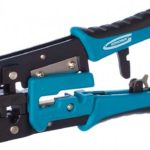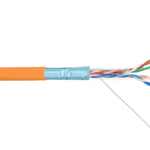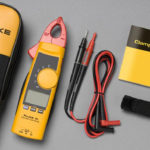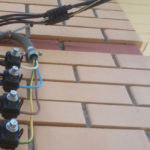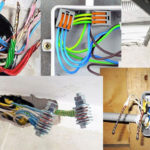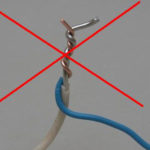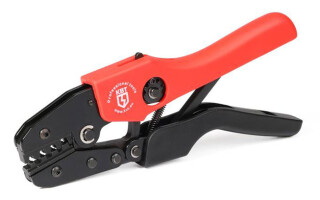Crimping pliers for automotive and similarly configured terminals are indispensable when working on a vehicle to make electrical connections using connectors or such terminals. In this article we will consider the peculiarities of using crimping pliers, their types and spheres of application.
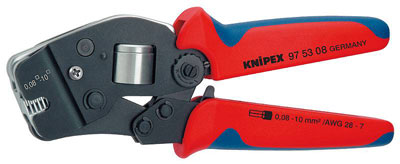
In the process of working with various cables it is necessary to connect them to electronic and household appliances. For this purpose, crimping pliers of various configurations and sizes are used for crimping wire lugs.
As the development of technology has led to the development of new types of wire connections for different purposes, with different power and conductivity levels, the design of cable connections has also been subject to change. In order to prepare the lead wire contacts, their lugs must be appropriately crimped by means of pincers.
The contents of .
Using the Crimping Pliers
Crimping pliers are widely used by radio amateurs, car mechanics and electricians in their work. Using crimping pliers is indispensable for crimping the pins of standard cables and specific connectors of non-standard connectors (for example, a network cable for a PC). Today the standard size crimping pliers are the best choice for this task.
The crimpers are designed to be quick and easy to crimp, and their operating principle ensures a firm and tight crimping. This ensures a strong bond between the conductors and the connecting element. The price of the crimping pliers is determined by the manufacturer, the type of construction, the quality and the material used.
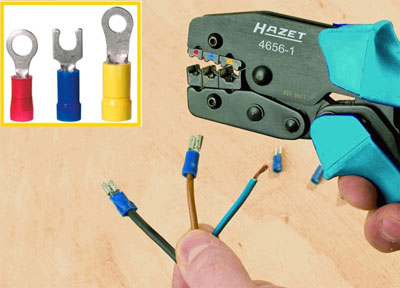
The crimping pliers are designed to perform crimping of insulated wires:
- NKI ring type tips;
- HWI tips of forked type;
- NShKI ring-type lugs; HVI fork-type lugs; NSHKI pin-type round lugs;
- flat and plug connectors RPI-P, RPI-M, RSI-P, RSI-M;
- piercing type OV taps
- GSI connection sleeves.
Pliers for crimping sleeves are widely used for flexible wires in the process of connecting circuit breakers, sockets, chandeliers and lamps.
Crimping of connection sleeves in the industry is carried out by using hydraulic crimping pliers, which are designed for cable cores with a cross section from 16 to 240 sq.mm.
Further in this article we will tell how to use manual and hydraulic crimping pliers, give the principles of their work and features of application. It is necessary to choose the pliers with the cross-section of the cable strand.
Main types and varieties of pliers
Today, many manufacturers produce crimping pincers based on various standards. Customers are offered pincers with a narrow scope of application (pressing of a particular type of cable) or a wide purpose (universal production pincers). So before you buy, you need to decide what type of tool you need.
When used in the home, the tool can have a multi-purpose purpose for crimping stranded wires for outlets, switches, and chandeliers.
The crimping pliers create a strong and safe connection of an electrical and mechanical nature. The crimping pliers are classified as a pressing tool and are often required for securing contacts in low current systems. The tools are divided into several varieties.
For stripping wire
This tool can be used to remove a section of insulation without damaging the wire. Manual and automatic setting of the required diameter to be removed from the core is allowed. In the case of manual setting of the diameter there is a risk of damaging the wire, while automatic setting allows the entire layer of insulation to be clearly removed. In most cases this type is used for distribution and junction boxes. And attention should be paid to the sharpness of the cutting edge so that it does not jam the wire.
For crimping sleeves
The pliers for pressing the end sleeves are differentiated by sockets and their shape. The sockets can be fitted with plastic flanges or without them. The plastic tips provide maximum crimping efficiency, and the square configuration ensures that all cores make firm contact. This type of device makes it easy to handle mounting or centering for all types of cable cross-sections. The pliers are selected by diameter according to the color markings for an extremely tight contact fit.
For insulated wire lugs
The insulated lug crimping pliers are characterized by an oval configuration. By standard, there are three standard shapes for the press, which differ in color - red, blue and yellow. Accordingly, tips, sleeves and other connectors with similar colors are provided for them. When working with the tool, it is necessary to ensure the correct positioning of the junction edge, it should be in the middle of the upper edge of the pincers. This design is designed in such a way that if it is positioned on the side, the edge breaks the tightness of the cable or wire.
For crimping bare cable lugs
These crimping pliers are used on bare wire, and on brass wires. The tool has a special rod for the press, which must be placed on the separation joint. Tools for crimping exposed brass cable can be provided for separate clamps - one for the core and one for the winding. The use of a locator is recommended to reinforce the press, which will ensure clear positioning.
Pliers for crimping twisted pair wire
Twisted pair crimping pliers are provided for 8 or 4 cores and are used to insert wires into the connector. For example, twisted pair is used when connecting a cable for a high-speed internet connection.

Crimping with a Hydraulic Tool
Hydraulic crimping pliers are used for crimping cables with large diameters of over 120 mm² for industrial applications. Hydraulic crimping pliers are similar to pliers or pliers, where lever handles actuate the crimping jaws to give the desired shape to the plastic connector. The result is a tight, secure connection.
Thanks to the hydraulic mechanism, the force required to actuate the tool is considerably reduced. It is possible to clamp the jack in several steps, gradually increasing the force. Most professional tools are equipped with a hydraulic mechanism.
How to use the crimping pliers correctly
Crimping pincers for lugs and sleeves assumes that the principle of their use to press contacts in the cable can be easily understood by the workflow in practice. The task will require a specific wire, the pliers, and a connecting component to be positioned at the end of the contacts. Here is a step by step instruction and rules for using the press pliers to do the crimping:
- Remove the outer winding from the cable using the pliers, which have a semicircular depression on top and a cutting edge on top;
- put the cable in the recess and press with the cutting edge on top;
- after several rotations around the wire, the insulation is notched all around the circumference and can easily be removed;
- 4 cm of stripping is allowed for a proper connection with a good contact;
- line up and arrange all wires in the proper sequence according to the type of connector and the color-coded markings;
- when all wires are spliced, clamp and cut, leaving 1.5 cm of contacts for further connection;
- insert the pins into the connector keeping their position. Twist the stranded wires strictly on the basis of the indicated colors in the diagram. Bring the strands so that the bottom notch of the connector touches the winding of the cable. This measure is necessary to minimize the risk of damaging the wire during crimping;
- place the device in the pliers, checking the colors beforehand. After checking, perform the crimping process;
- In the last stage, check the safety and secure fixation, as well as the integrity of the connector.
Press pliers are indispensable tools for crimping twisted pair, crimping insulated lugs and uninsulated cables. The tools are available in different sizes, with manual or hydraulic crimping for industrial applications and large wire diameters.
Related articles:
